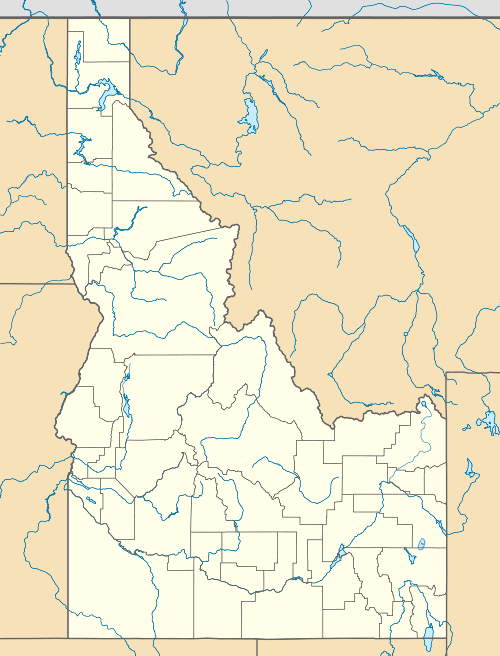Sagle, Idaho
| Sagle, Idaho | |
|---|---|
| Unincorporated community | |
| Nickname(s): south of town, the south side | |
| Motto: Never forget the land of 7B | |
 Sagle, Idaho | |
| Coordinates: 48°12′09″N 116°32′52″W / 48.20250°N 116.54778°WCoordinates: 48°12′09″N 116°32′52″W / 48.20250°N 116.54778°W | |
| Country | United States |
| State | Idaho |
| County | Bonner |
| Elevation | 2,149 ft (655 m) |
| Time zone | Pacific (PST) (UTC-8) |
| • Summer (DST) | PDT (UTC-7) |
| ZIP code | 83860 |
| Area code(s) | 208 |
| GNIS feature ID | 389817[1] |
Sagle is an unincorporated community in Bonner County, Idaho, United States. Sagle is 5 miles (8.0 km) south of Sandpoint. Sagle has a post office with ZIP code 83860.[2]
Sagle has an elementary school that lies on Sagle Road just off the main highway. The mascot of Sagle Elementary is the Hawks. The Sagle area has recently seen an expansion of businesses and commerce as it lies close to the population base in Sandpoint, features major highway frontage, and has fewer regulations and restrictions than nearby Sandpoint.
Climatology of Sagle
Sagle features a unique microclimate very different from Spokane and Coeur d'Alene, 50 miles to the south, and even from Sandpoint 6 miles to the north. Sagle generally features long cool winters with a healthy amount of precipitation. Most precipitation in the winter months occurs as snow, although it is standard to get one or two pineapple express days in the winter which can lead to rain and snowmelt. Winters generally feature snowfall on the ground from late November until early March, although snow can fall in October and can linger into April and May, most recently in the winter of 2007-2008.
Sagle enjoys weather that features all four seasons. Summers are generally sunny from June until September with temperatures consistently ranging from the low 80s to the mid 90s, although temperatures of 100 are not unheard of. Winters are cold and snowy, and there can be weeks without seeing the sun. Average annual precipitation is 30-35 inches, depending on the area of Sagle and local geography.
The winter of 1968-1969 was infamous among locals and old folks. Temperatures plunged to -40 before the New Year, followed by approximately 6-8 feet of snow in the month of January, with drifts up to 10 feet deep. School was cancelled nearly the entire month of January due to snow, and nearly the entire month of March had school off due to snowmelt causing widespread mud and floods.
More recently, the winter of 2007-2008 is one that will not be soon forgotten. Snow started around Thanksgiving and the area was hit with several storms over the next two months, each dumping between 6 and 18 inches of fresh snow. Depths reached 48 inches across the area, with reports from isolated areas reaching depths of 60 inches in the middle of February. The resulting snow caused an extreme delay of spring, with bare ground only appearing in the 3rd week of April, and it was not until May that all of the snow was melted from the area.
Geography
Sagle is characterized by low, rolling hills bordered by larger mountains. The vast majority of the population live along the valley floor or among the low hiils that dot the region. However, there are some who live farther back in the mountains. There are two main mountain ranges, one flanking the west of Sagle and one flanking the east. Both ranges run roughly north to south. The western range consists of Ott's Basin, the Dufort area, and runs south toward Huckleberry and Long Mountains. The eastern mountains are more prominent and form a chain from Gold Hill southward for nearly 30 miles all the way to Cape Horn near Bayview, Idaho. The only major road that crosses this eastern chain is Sagle Road, which noticeably climbs steadily until a steep hill winds down toward Lake Pend Oreille and the small resort town of Garfield Bay. These mountains feature the most diverse array of flora and fauna in the Sagle region, with sightings of deer, elk, moose, and turkeys very common. Bears, cougars, and even the occasional wolf are sometimes observed in this chain. The flora features a wide variety of trees, from the sun-loving western larch and ponderosa pine to the shade-tolerant western red cedar and western hemlock. Additionally, huckleberry patches are widespread throughout these hills, although most locals won't tell you where their favorite place is.
References
| |||||||||||||||||||||